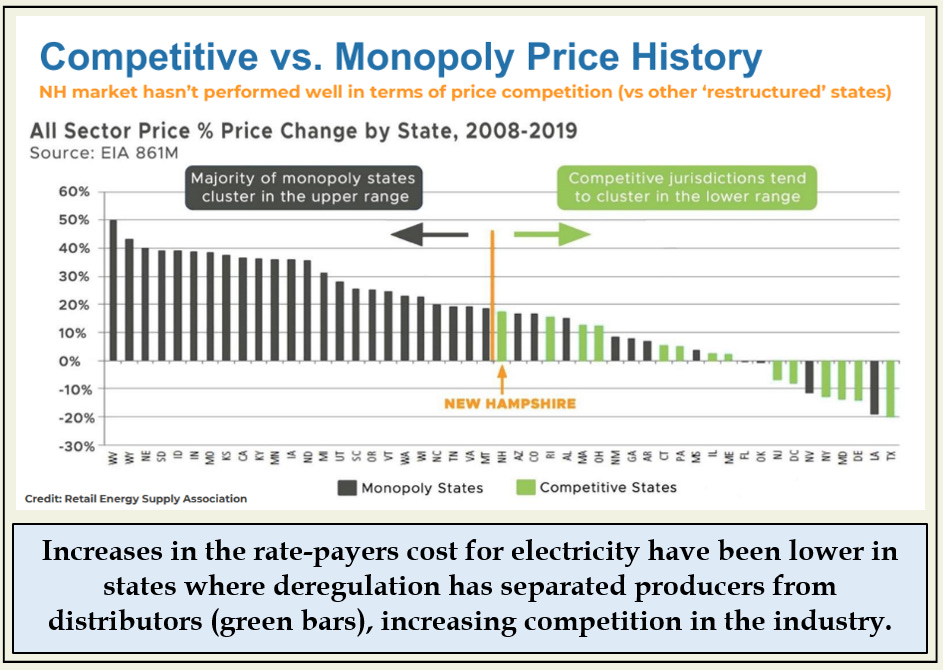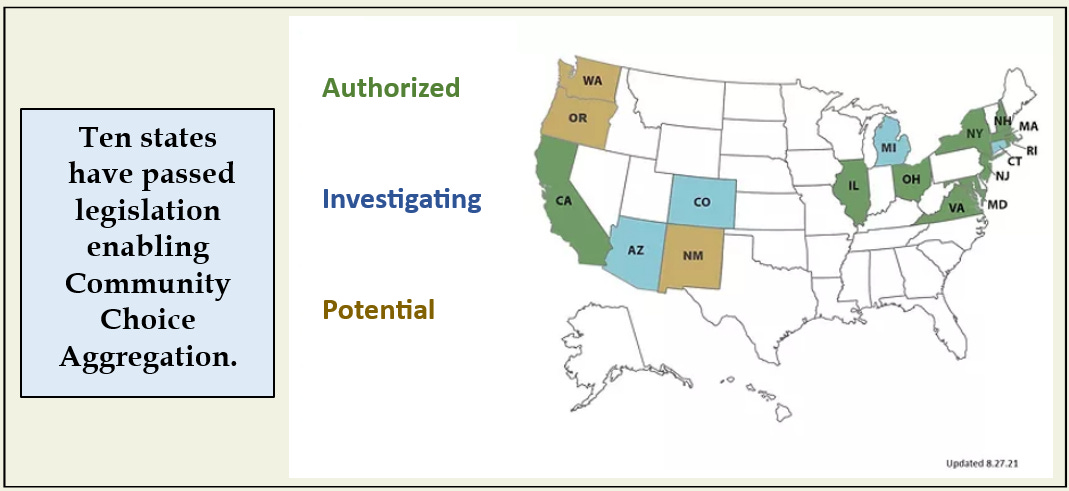You May Not Need A Roof in the Sun to Access Solar Energy
Communities create a market for renewable energy from the bottom up
In addition to now standard ways of accessing low-carbon energy, there is another innovative process emerging at the community level. Community Choice Aggregation allows individuals to join forces to achieve lower electric rates and determine what fraction of their power comes from low-carbon sources.
Community Choice Aggregation Allows Consumers to Increase Use of Low-Carbon Energy Sources
What if, with the click of an icon, you could decide that 33%, 50%, even 100% of the electricity you consume would be generated from renewable sources like solar, wind and hydro?
Solar panels are appearing on homes and businesses everywhere, tapping into the one energy source that can meet all our needs. But most of us lack the space or sun angle to manage energy “behind the meter” in this way.
But now there is something new in the mix of opportunities to lower your personal or household greenhouse gas footprint. In certain part of the U.S., anyone who pays an electric bill can make that renewable energy choice through a new process called Community Choice Aggregation (CCA).
Most of us in the U.S. receive electricity from a regulated monopoly that controls both supply and delivery. The exceedingly complex national grid that is tasked with moving energy from source to use is not really a national beast at all, but a conglomeration of dozens of privately-owned companies whose contradictory priorities and limited capacity have blocked the integration of renewable energy projects into the national energy ecosystem.
But in some states, an equally complex set of changes gathered under the umbrella term of “deregulation” has had the effect of separating companies that produce electricity (they own the power plants) from those that deliver it (they own the wires, poles and meters).
This creates opportunities for competition among different companies that produce electric power in different ways. There is still only one set of wires, but the power drawn from those wires by consumers can be loaded into the regional grid from a range of sources.
Deregulation and Energy Prices
The goal of deregulation was to create competition in the marketplace and reduce prices, and the results suggest that has been successful. Increases in price per kWh have been lower (2008-2019) in states where supply is competitive and the producer/distributor link has been broken.
This is good news for consumers, but choices on the source of the energy distributed are still made at the utility level. Controls on greenhouse gas emissions come from state- and national-level policies and directives, not from consumer choice.
Bringing Community Choice Into the Mix
But Community Choice Aggregation (CCA) brings communities and consumers into the mix. The USEPA, who sponsors but does not fund this initiative, describes the program this way:
CCA programs allow local governments to procure power on behalf of their residents, businesses, and municipal accounts from an alternative supplier while still receiving transmission and distribution service from their existing utility provider. CCAs are an attractive option for communities that want more local control over their electricity sources, more green power than is offered by the default utility, and/or lower electricity prices. By aggregating demand, communities gain leverage to negotiate better rates with competitive suppliers and choose greener power sources.
Lower rates and greener sources carry equal weight in this description.
Establishing CCA requires state-level enabling legislation. So far 10 states have taken this step.
The action then moves to the community level, and will take different forms depending on the history, politics, and organizational structure in each state. To go deeper into this story, we’ll have to limit this essay to one state.
One State’s Experience
My home state of New Hampshire passed CCA enabling legislation and rules in 2021. This was followed by the formation of the Community Partner Coalition of New Hampshire, a non-profit organization governed “by communities, for communities” - empowering towns, cities and counties across New Hampshire to:
- Streamline the process for authorizing a Community Power program locally.
- Share services and staff support across member cities, towns and counties.
- Participate in joint power solicitations and local project development opportunities.
- Share knowledge and collaborate regionally on clean energy and resilient infrastructure development.
- Speak with one voice at the Legislature and Public Utilities Commission on public advocacy issues related to energy and Community Power.
So far, 19 cities, towns and counties have joined the coalition, and while any town can opt in or out of the state-wide program, the economic leverage increases as the number of members increases.
My town of Durham has an Energy Task Force made up of citizen-volunteers who were charged with reviewing the merits of joining the statewide coalition. Their analysis was positive and the town council approved joining in 2021, with a target date of implementation in January of 2024.
As that date approached, steps were taken to notify residents of the available options and the date a decision needed to be made. While the town as an entity is in the program, individuals can choose to opt out and return to the rate charged by our utility - Eversource.
And at the end of this chain of actions, we finally come to the “clicking-the-icon” moment (energy policy and regulation is very complex, even in a deregulated state!). Durham residents were given this set of choices.
Negotiated at the state level, this table applies to all member towns and counties.
The leverage of combining purchasing power across the state is reflected in the modest decrease from 8.285 cents per kWh from Eversource versus 8.1 cents from the coalition.
The more significant shift is the ability to pay more to assure a higher percentage of electricity comes from renewable sources.
State policy now requires that electric utilities acquire 24.3% of their electricity from renewable sources, so that is what Eversource does. The New Hampshire CCA project uses the term “opting up” for consumers selecting a higher percentage of renewables.
Definitions and Other Challenges
Two questions came to mind immediately while working through this.
1. Is nuclear energy considered renewable?
2. How can a regional power company quickly pivot to increase the percentage of power from renewable sources?
The first question is the simpler one – no, nuclear is not considered renewable in this context. Renewable sources are limited to solar, wind, hydro, geothermal, etc. The “Clean and Renewable Energy Mix” page for Eversource says that 37% of their energy is from renewable AND non-carbon sources. The difference between 24.3% and 37% would be mainly from nuclear power plants in the region. So nuclear is considered non- (or low-) carbon emitting, but not renewable.
The pivoting question is a harder one. Several essays here have stressed the difficulty new renewable energy sources face in trying to connect to the grid. How could the coalition and Eversource respond to increased demand for renewables?
The mechanism for this is Renewable Energy Credits (or RECs). These are market-based certificates that transfer credit for producing renewable energy from the producer to whoever buys the credits. That renewable power can be produced anywhere in the country.
You can imagine this gets complicated, and you might wonder what would happen if all of the coalition’s rate payers opted for the 100% renewable selection! Would there be enough RECs out there to meet that demand?
Probably not, but then that outcome is very unlikely. If demand for the 100% renewable rate went way up, perhaps the price per kWh for that option would have to go up as well (rates are reviewed every six months). This is the way any market works.
Using the Market to Increase Demand for Renewable Energy
Bottom line, I think, is that opting for a higher percentage of renewable electricity increases demand for renewable energy, increases the cost of RECs, and increases the profitability of renewable energy enterprises, which should result in greater investment.
Markets are never simple and not always predictable, but there is real power now through consumer choice and market demand that was not available before CCA.
Sources
Figures related to Community Choice Aggregation are from:
https://www.epa.gov/green-power-markets/community-choice-aggregation
www.communitypowernh.gov/durham
The figure on energy sources for Eversource is from:










